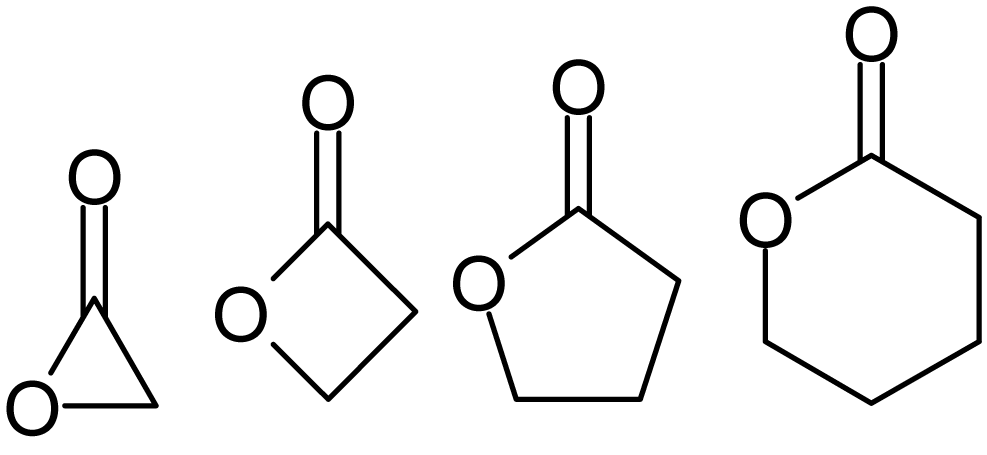Lactone Types on:
[Wikipedia]
[Google]
[Amazon]
Lactones are cyclic carboxylic esters, containing a 1-oxacycloalkan-2-one structure (), or analogues having unsaturation or heteroatoms replacing one or more carbon atoms of the ring.
Lactones are formed by intramolecular esterification of the corresponding hydroxycarboxylic acids, which takes place spontaneously when the ring that is formed is five- or six-membered. Lactones with three- or four-membered rings (α-lactones and β-lactones) are very reactive, making their isolation difficult. Special methods are normally required for the laboratory synthesis of small-ring lactones as well as those that contain rings larger than six-membered.
 Lactones are usually named according to the precursor acid molecule (''aceto'' = 2 carbon atoms, ''propio'' = 3, ''butyro'' = 4, ''valero'' = 5, ''capro'' = 6, etc.), with a ''-lactone'' suffix and a
Lactones are usually named according to the precursor acid molecule (''aceto'' = 2 carbon atoms, ''propio'' = 3, ''butyro'' = 4, ''valero'' = 5, ''capro'' = 6, etc.), with a ''-lactone'' suffix and a
Nomenclature
 Lactones are usually named according to the precursor acid molecule (''aceto'' = 2 carbon atoms, ''propio'' = 3, ''butyro'' = 4, ''valero'' = 5, ''capro'' = 6, etc.), with a ''-lactone'' suffix and a
Lactones are usually named according to the precursor acid molecule (''aceto'' = 2 carbon atoms, ''propio'' = 3, ''butyro'' = 4, ''valero'' = 5, ''capro'' = 6, etc.), with a ''-lactone'' suffix and a Greek letter
The Greek alphabet has been used to write the Greek language since the late 9th or early 8th century BCE. It is derived from the earlier Phoenician alphabet, and was the earliest known alphabetic script to have distinct letters for vowels as ...
prefix that specifies the number of carbon atoms in the heterocycle — that is, the distance between the relevant -OH and the -COOH groups along said backbone. The first carbon atom after the carbon in the -COOH group on the parent compound is labelled α, the second will be labeled β, and so forth. Therefore, the prefixes also indicate the size of the lactone ring: α-lactone = 3-membered ring, β-lactone = 4-membered, γ-lactone = 5-membered, etc. Macrocyclic lactones are known as macrolactones.
The other suffix used to denote a lactone is ''-olide'', used in substance class names like '' butenolide'', ''macrolide
The Macrolides are a class of natural products that consist of a large macrocyclic lactone ring to which one or more deoxy sugars, usually cladinose and desosamine, may be attached. The lactone rings are usually 14-, 15-, or 16-membered. M ...
'', '' cardenolide'' or '' bufadienolide''.
To obtain the preferred IUPAC names, lactones are named as heterocyclic pseudoketones by adding the suffix ‘one’, ‘dione’, ‘thione’, etc. and the appropriate multiplicative prefixes to the name of the heterocyclic parent hydride.
Etymology
The name ''lactone'' derives from the ring compound called lactide, which is formed from the dehydration of 2-hydroxypropanoic acid (lactic acid
Lactic acid is an organic acid. It has a molecular formula . It is white in the solid state and it is miscible with water. When in the dissolved state, it forms a colorless solution. Production includes both artificial synthesis as well as natur ...
) CH3-CH(OH)-COOH. Lactic acid, in turn, derives its name from its original isolation from soured milk (Latin: lac, lactis). The name was coined in 1844 by the French chemist Théophile-Jules Pelouze, who first obtained it as a derivative of lactic acid. An internal dehydration reaction within the same molecule of lactic acid would have produced alpha-propiolactone, a lactone with a 3-membered ring.
In 1880 the German chemist Wilhelm Rudolph Fittig extended the name "lactone" to all intramolecular carboxylic esters.
Natural sources
Naturally occurring lactones are mainly saturated and unsaturated γ- and δ-lactones, and to a lesser extent macrocyclic lactones. The γ- and δ-lactones are intramolecular esters of the corresponding hydroxy fatty acids. They contribute to the aroma of fruits, butter, cheese, and other foods. Cyclopentadecanolide is responsible for the musklike odor of angelica root oil. Of the naturally occurring bicyclic lactones, phthalides are responsible for the odors of celery and lovage oils, and coumarin for woodruff. Lactones are present in oak wood, and they contribute to the flavour profile of Barrel-aged beers. Lactone rings occur widely as building blocks in nature, such as in ascorbic acid, kavain, nepetalactone, gluconolactone, hormones ( spironolactone, mevalonolactone), enzymes ( lactonase),neurotransmitter
A neurotransmitter is a signaling molecule secreted by a neuron to affect another cell across a synapse. The cell receiving the signal, any main body part or target cell, may be another neuron, but could also be a gland or muscle cell.
Neur ...
s (butyrolactone Butyrolactone may refer to:
* ''beta''-Butyrolactone
* ''gamma''-Butyrolactone (GBL)
{{Short pages monitor